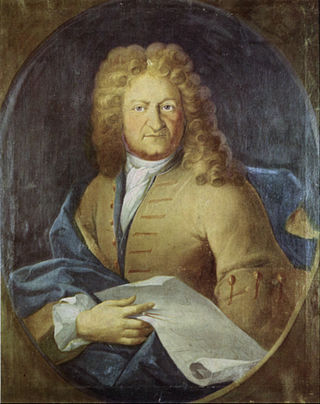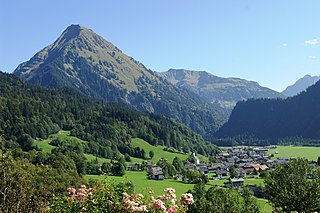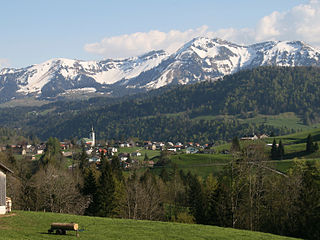
Vorarlberg is the westernmost state of Austria. It has the second-smallest geographical area after Vienna and, although it also has the second-smallest population, it is the state with the second-highest population density. Two thirds of the country are situated above 1,000m. It borders three countries: Germany, Switzerland, and Liechtenstein. The only Austrian state that shares a border with Vorarlberg is Tyrol, to the east.

Dornbirn is a city in the westernmost Austrian state of Vorarlberg. It is the administrative centre for the district of Dornbirn, which also includes the town of Hohenems, and the market town Lustenau.

The Bregenzerwald is one of the main regions in the state of Vorarlberg (Austria). It overlaps, but is not coterminous with, the Bregenz Forest Mountains, which belong to a range of the Northern Limestone Alps, specifically the northern flysch zone. It is the drainage basin of the Bregenzer Ach river.

Mellau is a town in the Bregenz Forest in the westernmost Austrian state of Vorarlberg, part of the district of Bregenz.

The Vorarlberg School of Architecture or Guild of Au refers to a group of architects and builders founded in 1657 by Johann Michael Beer in the town of Au im Bregenzerwald in Vorarlberg (Austria).

The Bezirk Bregenz is an administrative district (Bezirk) in Vorarlberg, Austria. It comprises the Bregenz Forest region, the Leiblach valley, and the Austrian part of Lake Constance.

Franz Beer, also known as Franz Beer von Blaichten, was an Austrian architect during the Baroque period, mainly working on church buildings at monasteries in southern Germany, chiefly in Upper Swabia, and Switzerland. His son Johann Michael Beer also was an architect.

Krumbach is a village in the westernmost Austrian state of Vorarlberg, in the Bregenz district. The municipality has about 1,000 inhabitants.

Schoppernau is a town in the Bregenzerwald Region of the Austrian state of Vorarlberg. Schoppernau has an area of 47.64 km2.

Damüls is a village community and popular tourist resort in the district of Bregenz in the westernmost Austrian state of Vorarlberg.

Hittisau is a municipality in the district of Bregenz in the Austrian state of Vorarlberg. Hittisau has a surface area of 46.65 km2. It lies in the Bregenzerwald in the west of the country.

Langenegg is a municipality with approx. 1,200 inhabitants in the westernmost Austrian state, Vorarlberg.

Lingenau is a municipality in the district of Bregenz, in the westernmost Austrian state of Vorarlberg.

The Kanisfluh is a mostly isolated massif in the central Bregenz Forest Mountains between the municipalities Mellau and Au.The Kanisfluh is considered the most famous mountain and landmark of the Bregenz Forest, Vorarlberg, Austria.

The Bregenz Forest Mountains, also the Bregenzerwald Mountains, are a range of the Northern Limestone Alps and Eastern Alps, named after the town of Bregenz. The Bregenz Forest Mountains are located entirely in the Austrian state of Vorarlberg.

Villa Maund is a villa in Schoppernau, Hopfreben in Vorarlberg, Austria, built for Sir John Oakley Maund between 1891 and 1895.

Kaspar Albrecht was an Austrian architect and sculptor.

The Großes Walsertal is a valley located in the Austrian state of Vorarlberg. It is a side valley of the Walgau and stretches from there north to the mountainous center of the country. The end of the valley borders on the Bregenz Forest.

Franz Michael Felder was a social reformer, author and farmer from Vorarlberg (Austria).

The Werkraum Bregenzerwald is a cooperation and association of craftsmen and traders in the Bregenz Forest (Austria) founded in 1999.























